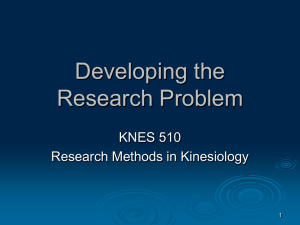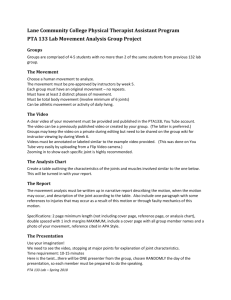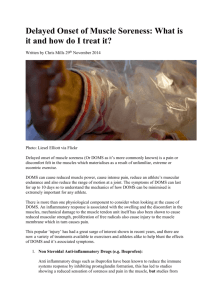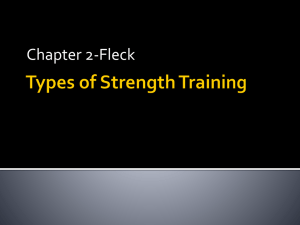Delayed Onset Muscle Soreness (DOMS)
advertisement
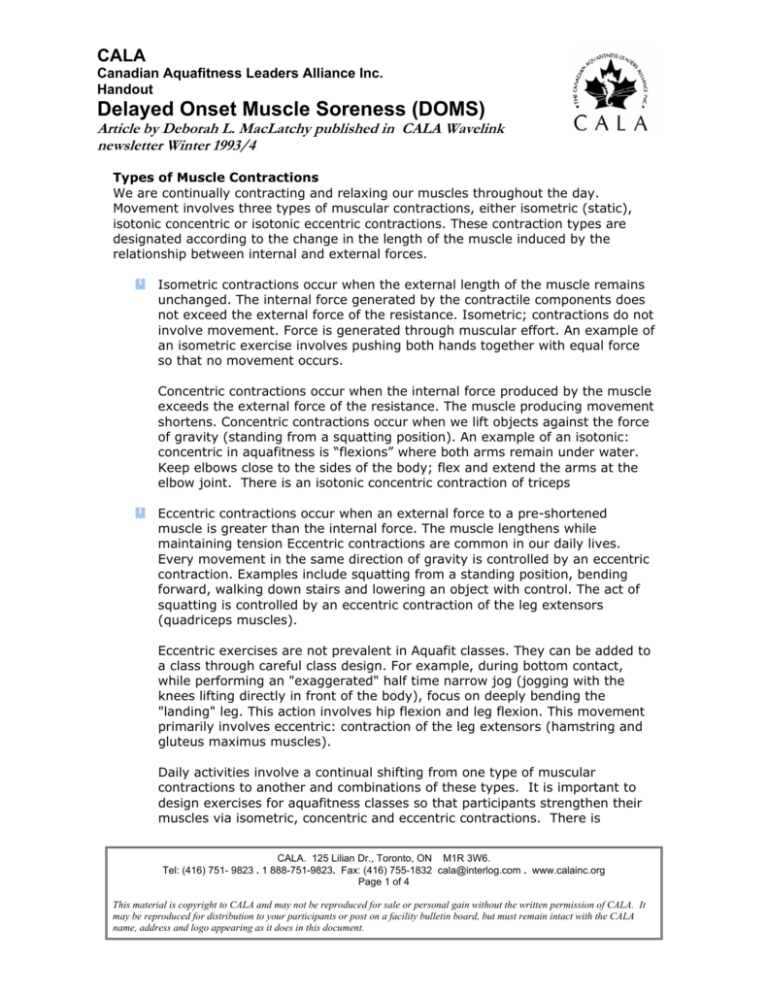
CALA Canadian Aquafitness Leaders Alliance Inc. Handout Delayed Onset Muscle Soreness (DOMS) Article by Deborah L. MacLatchy published in CALA Wavelink newsletter Winter 1993/4 Types of Muscle Contractions We are continually contracting and relaxing our muscles throughout the day. Movement involves three types of muscular contractions, either isometric (static), isotonic concentric or isotonic eccentric contractions. These contraction types are designated according to the change in the length of the muscle induced by the relationship between internal and external forces. Isometric contractions occur when the external length of the muscle remains unchanged. The internal force generated by the contractile components does not exceed the external force of the resistance. Isometric; contractions do not involve movement. Force is generated through muscular effort. An example of an isometric exercise involves pushing both hands together with equal force so that no movement occurs. Concentric contractions occur when the internal force produced by the muscle exceeds the external force of the resistance. The muscle producing movement shortens. Concentric contractions occur when we lift objects against the force of gravity (standing from a squatting position). An example of an isotonic: concentric in aquafitness is “flexions” where both arms remain under water. Keep elbows close to the sides of the body; flex and extend the arms at the elbow joint. There is an isotonic concentric contraction of triceps Eccentric contractions occur when an external force to a pre-shortened muscle is greater than the internal force. The muscle lengthens while maintaining tension Eccentric contractions are common in our daily lives. Every movement in the same direction of gravity is controlled by an eccentric contraction. Examples include squatting from a standing position, bending forward, walking down stairs and lowering an object with control. The act of squatting is controlled by an eccentric contraction of the leg extensors (quadriceps muscles). Eccentric exercises are not prevalent in Aquafit classes. They can be added to a class through careful class design. For example, during bottom contact, while performing an "exaggerated" half time narrow jog (jogging with the knees lifting directly in front of the body), focus on deeply bending the "landing" leg. This action involves hip flexion and leg flexion. This movement primarily involves eccentric: contraction of the leg extensors (hamstring and gluteus maximus muscles). Daily activities involve a continual shifting from one type of muscular contractions to another and combinations of these types. It is important to design exercises for aquafitness classes so that participants strengthen their muscles via isometric, concentric and eccentric contractions. There is CALA. 125 Lilian Dr., Toronto, ON M1R 3W6. Tel: (416) 751- 9823 . 1 888-751-9823. Fax: (416) 755-1832 cala@interlog.com . www.calainc.org Page 1 of 4 This material is copyright to CALA and may not be reproduced for sale or personal gain without the written permission of CALA. It may be reproduced for distribution to your participants or post on a facility bulletin board, but must remain intact with the CALA name, address and logo appearing as it does in this document. CALA Canadian Aquafitness Leaders Alliance Inc. Handout Delayed Onset Muscle Soreness (DOMS) Article by Deborah L. MacLatchy published in CALA Wavelink newsletter Winter 1993/4 however, evidence which exists suggesting that all types of contractions are not equally beneficial or safe for participants. Ensuring that the duration and intensity of the eccentric components of muscle contraction are at a level suitable for your participants (will keep them feeling healthy, successful and coming back for more. Delayed Onset Muscular Soreness At one time or another, each of us has experienced DOMS. Simply remember your first racquet sport match of the season, your first ski trip or your first time attempting a new sport. DOMS is the sensation of discomfort or pain that occurs in the muscles following the exercising of muscles that are no accustomed to working. The soreness normally increases in intensity during the first 24 hours after exercise, peaks from 24 to 72 hours, then subsides 5 to 7 days after exercising. There is often a sense of reduced mobility or flexibility and the muscles may be sensitive to touch or movement. There are a number of suggested reasons explaining why DOMS occurs. It may be caused by: 1) minute tears in the muscle tissue itself, 2) fluid build-up in surrounding tissues 3) muscle spasms, and 4) over stretching and perhaps tearing of the muscle's connective tissue harness and associated tendons (McCardle et al. 1986). All of these reasons are not equally supported by experimental results. Evidence most strongly suggests that microscopic tears in the muscle and damage to connective tissue associated with the muscles are the prime factors involved in production of DOMS. Roles of Concentric and Eccentric Contractions in Producing DOMS Talag (1973) tested human subjects for DOMS, following concentric, eccentric and isometric exercise. Talag demonstrated that eccentric contractions affect greater residual muscular soreness than either concentric or isometric exercise, with the peak occurring after 48 hours. Muscular strength also decreased following eccentric contractions and remains depressed throughout the duration of the soreness period Clarkson et all (1986) were able to show that concentric arm flexion exercises (bicep curls) minimized the DOMS in comparison to arm flexion eccentric exercises. Exercises involving both concentric and eccentric exercises produced a greater perception of soreness. The use of hydraulic resistive devices (Hydra Fitness) that involve concentric only contractions produced CALA. 125 Lilian Dr., Toronto, ON M1R 3W6. Tel: (416) 751- 9823 . 1 888-751-9823. Fax: (416) 755-1832 cala@interlog.com . www.calainc.org Page 2 of 4 This material is copyright to CALA and may not be reproduced for sale or personal gain without the written permission of CALA. It may be reproduced for distribution to your participants or post on a facility bulletin board, but must remain intact with the CALA name, address and logo appearing as it does in this document. CALA Canadian Aquafitness Leaders Alliance Inc. Handout Delayed Onset Muscle Soreness (DOMS) Article by Deborah L. MacLatchy published in CALA Wavelink newsletter Winter 1993/4 less DOMS 25 hours post-exercise than concentric eccentric combined contractions (Byrnes et all, 1985) In addition to DOMS, actual muscle damage has been shown in muscles exercised eccentrically as opposed to concentrically. By examing the effects on the quadriceps muscles of stepping up and down (step u, contraction is concentric; step down, contraction is eccentric), Newham et all (1983) demonstrated that the muscles which had contracted concentrically showed no abnormalities, which the muscles that had contracted eccentrically showed microscopic dame immediately after exercise. The dame became more marked 24 to 48 hours later. It was suggested that the original damage is mechanically induced by the high tensions generated during and eccentric contraction. The exacerbation of damage is not related to the general fitness of the subject.) Remember that DOMS is produced when we use muscles that are unaccustomed to eccentric contractions. Should Concentric Exercises Replace 1: Eccentric: Exercises in Fitness Classes'? Given that concentric exercises reduce DOMS, are not associated wills decreased post-exercise strength, and do not produce microscopic: damage, should we replace all the eccentric exercises in our aquafitness classes with concentric exercises? Probably not! It is important to note that training of muscles appears to be highly specific, not only for particular muscles, but for the type of contract ions performed. We cannot function in our day to day life without eccentric contractions (once you go up stairs, you have to go down them). Eccentric exercises are an integral part of a fitness regime. Introduce eccentric exercises to a beginner class in limited sets with few repetitions. This will decrease the chances of DOMS and damage to muscles, but will allow for strengthening of eccentric muscle contractions. (Aside: many people drop out of fitness classes because they do too much too soon, resulting in injury or discomfort due to post-exercise DOMS.) Ensuring that the duration and intensity of the eccentric components of muscle contraction are at a level suitable for your participants will keep them feeling healthy, successful and coming back for more. If your participants do complain of delayed muscular soreness, give them modifications of eccentric contractions in the affected muscles. The best method of reducing DOMS is to exercise the sore muscles. CALA. 125 Lilian Dr., Toronto, ON M1R 3W6. Tel: (416) 751- 9823 . 1 888-751-9823. Fax: (416) 755-1832 cala@interlog.com . www.calainc.org Page 3 of 4 This material is copyright to CALA and may not be reproduced for sale or personal gain without the written permission of CALA. It may be reproduced for distribution to your participants or post on a facility bulletin board, but must remain intact with the CALA name, address and logo appearing as it does in this document. CALA Canadian Aquafitness Leaders Alliance Inc. Handout Delayed Onset Muscle Soreness (DOMS) Article by Deborah L. MacLatchy published in CALA Wavelink newsletter Winter 1993/4 Exercise works more effectively in reducing DOMS than heat, topical remedies containing methanols or camphors, or anti-inflammatory drugs )Armstrong, 1984) As muscles strengthen, increased levels of activity are needed to induce DOMS. The DOMS that results from eccentric contractions exercise is reduced specifically by training that involves eccentric contractions (Newham et al, 1982). Muscle will adapt to exercise induced damage. As adaptation takes place, the muscle becomes more resistant to damage and any damage that does occur will repair at a faster rate (Clarkson and Tremblay, 1988). In summary, isotonic eccentric; contractions cause increased levels of DOMS as compared to isometric: and isotonic; concentric contractions. Deep (suspended) or chest deep aquafitness exercises involve little, if any, eccentric contraction. Therefore the amount of DOMS will be greatly reduced. Educated by this knowledge about DOMS, aquafitness leaders can now offer a scientific explanation for the relatively pain free experiences associated with participation in aquafitness classes. Even true beginner participants can complete their first aquafitness class with very little DOMS compared to what they may experience following a land based aerobics class. This is a definite bonus. NO PAIN!! LOTS OF GAIN! ! CALA. 125 Lilian Dr., Toronto, ON M1R 3W6. Tel: (416) 751- 9823 . 1 888-751-9823. Fax: (416) 755-1832 cala@interlog.com . www.calainc.org Page 4 of 4 This material is copyright to CALA and may not be reproduced for sale or personal gain without the written permission of CALA. It may be reproduced for distribution to your participants or post on a facility bulletin board, but must remain intact with the CALA name, address and logo appearing as it does in this document.
